AMD AM1 Kabini Part 2: Athlon 5350/5150 and Sempron 3850/2650 Tested
by Ian Cutress on May 29, 2014 2:00 PM ESTSYSMark and Scientific Benchmarks
SYSmark 2014
SYSmark is developed by BAPCo, the Business Applications Performance Corporation, which includes in its current members Intel, Dell, Lenovo, Microsoft, Samsung, Sony, and Toshiba. The latest version of SYSmark, SYSmark 2014, uses the latest software packages from Adobe and Microsoft and meshes them together into a stringent testing package that can take a couple of hours to run. The end result gives marks for in office productivity, media creation and data/financial analysis sections as well as an overall result. SYSmark uses a standard office computer (an i3-4130 with a 500GB mechanical drive, 6GB DRAM, 1080p, integrated HD4400 graphics) to provide a benchmark score of ‘1000’, and all results are compared to this. Our testing runs the processors at 1080p with integrated graphics on an OCZ Vertex 3 240GB SF-2281 based SSD.
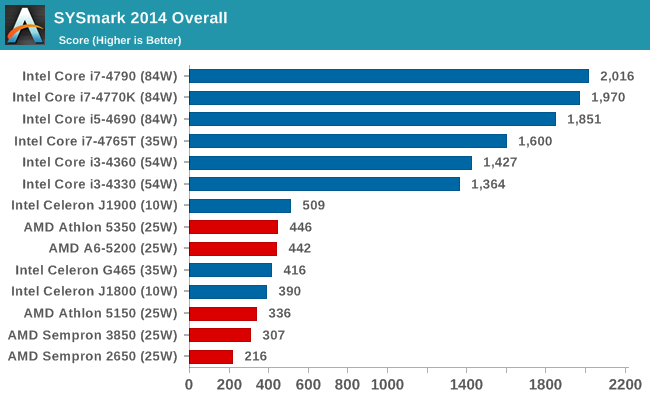
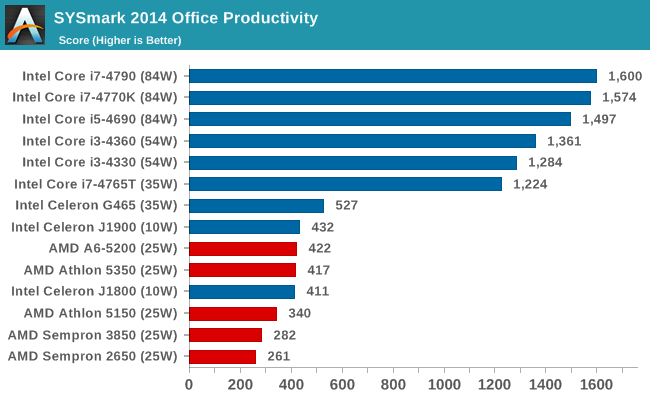
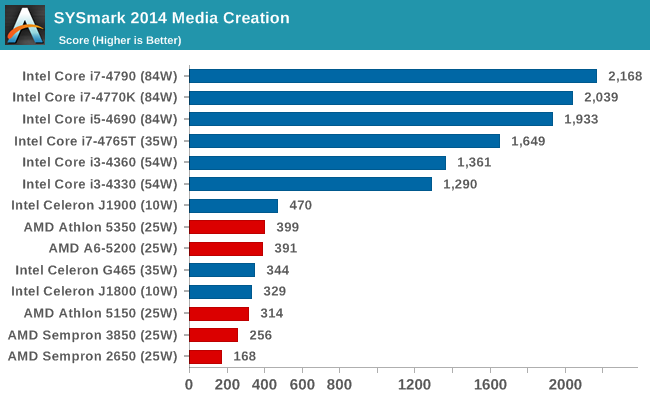
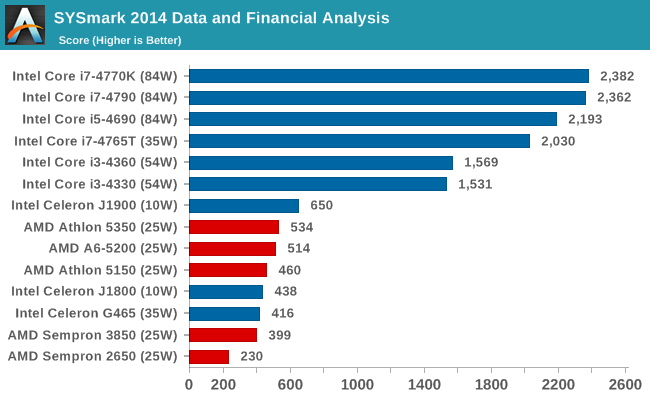
Point Calculations – 3D Movement Algorithm Test: link
3DPM is a self-penned benchmark, taking basic 3D movement algorithms used in Brownian Motion simulations and testing them for speed. High floating point performance, MHz and IPC wins in the single thread version, whereas the multithread version has to handle the threads and loves more cores.
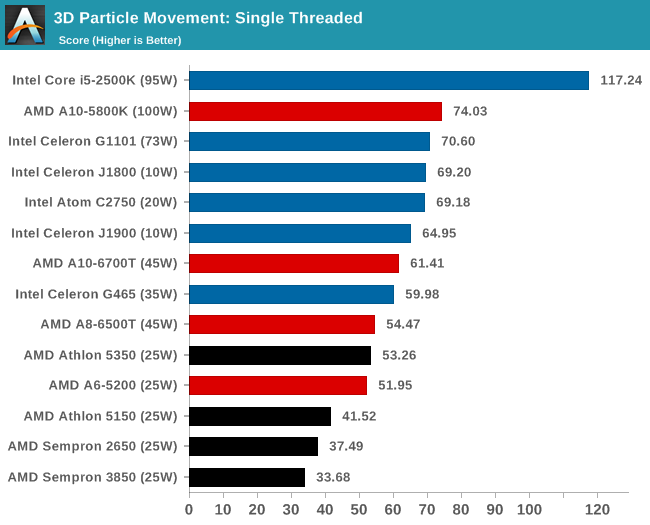
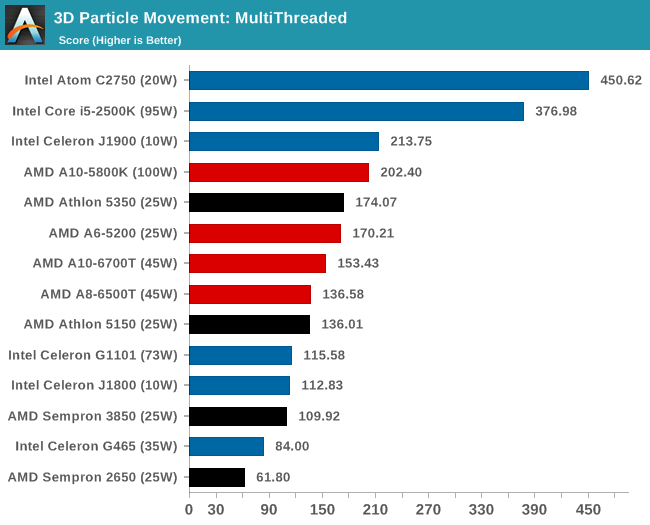
OpenCL – CompuBench: link
CompuBench is an OpenCL and RenderScript benchmark designed by Kishonti for both CPUs and any GPGPU capable device. While it offers almost two dozen tests, we select the more real-world tests in terms of fluid simulation and image analysis benchmarks.
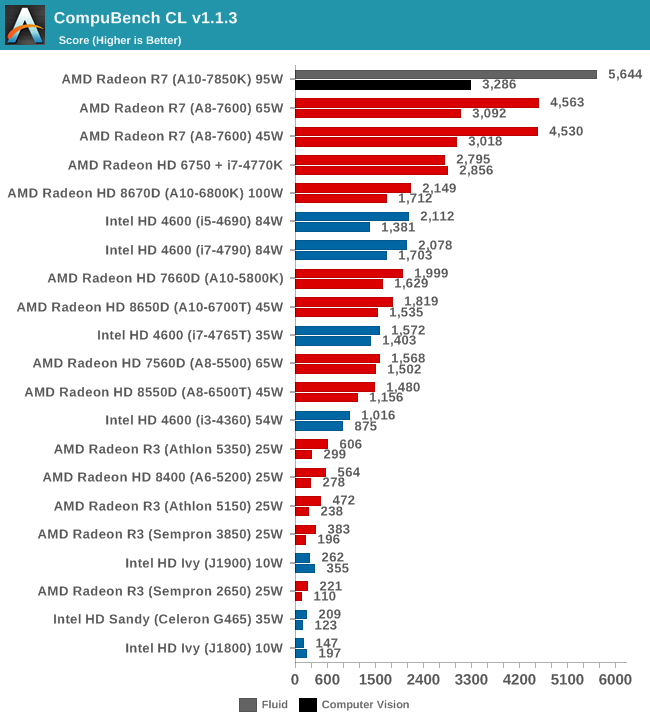










87 Comments
View All Comments
Ian Cutress - Thursday, May 29, 2014 - link
I've taken test data from all of my old testing as well, where I've run the same benchmarks on the same OS and SSD, hence why there are many data points to choose from. I have adjusted several of the graphs to have a narrower band of data showing to more easily see the difference now. Unfortunately the even older data (pre Core 2) is before my time at AnandTech.Regarding the J1800/J1900 motherboards, the two that I hurried in for testing were unfortunately limited in the GPU aspect and a third one I have since received is also in the same boat. Due to the hurried nature of getting the data from the initial release (as well as other testing on hand) I had perhaps wrongly assumed that all J1800/J1900 motherboards were in the same boat.
I am shifting my test stations around somewhat this week, so when I come back from Computex I will have more of a low power/DRAM testing setup alongside the higher power systems I normally test. If you want to see anything specific, please feel free to email.
edwpang - Friday, May 30, 2014 - link
It's definitely makes better sense than current review. As someone has already, using 1250w PS on this low end setup is kindly uselessly.piroroadkill - Thursday, May 29, 2014 - link
Truecrypt link seems like a bad idea right now, since the official Truecrypt site is in a terrible state of limbo where nobody can figure out whether it's discontinued by the devs or been hacked. Benchmarks for 7.1a are relevant, but 7.2 is a gutted, useless pile of crap. Just saying.A5 - Thursday, May 29, 2014 - link
It's good thing the bench is 7.1a then?Ian Cutress - Thursday, May 29, 2014 - link
Ha! I thought about taking the data out given that I had already uploaded almost all it before that announcement was made. However 7.1a is still viable and I still have the installer, so it might still be relevant if the installer still floats around in cyberspace. I somehow doubt we will ever get a full explanation from the developers on why they took it down, though there are many theories about it.Runamok81 - Thursday, May 29, 2014 - link
Typo, second to last sentence. platgormsomeeeguy - Thursday, May 29, 2014 - link
Ian, in the "dGPU Benchmarks with ASUS HD7970" portion of your review, it would have been interesting to see some Mantle results on these low power CPUs.JBVertexx - Thursday, May 29, 2014 - link
I think the value in having a socket solution is less about providing an upgrade path and more about lower carrying costs in the entire supply chain.If you look at having 4 CPU combinations over lets say 4 motherboard options, having a BGA solution means that you need to source and stock 16 different items. With a socket solution, that cuts your inventory and carrying cost down to 8 items.
The economics of this are huge. It impacts motherboard manufacturers, system builders, and businesses. It impacts the amount of up front investment required by every organization in the supply chain, and it impacts the inventory costs (or carrying capital).
It especially impacts motherboard manufacturers, who must actually purchase the CPU in a BGA solution in order to sell a motherboard.
In the face of those compelling economics, having an upgrade path is really small potatoes.
marvee - Thursday, May 29, 2014 - link
The understanding of those economics could be the experience of Rory Read, from his time with Lenovo.Hrel - Thursday, May 29, 2014 - link
Pretty disappointing you guy didn't include a CPU with HD4600 on it in the gaming benchmarks. Why compare to last generation's hardware? Perhaps to show AMD in as favorable a light as possible? hmmmmm.....